|
NHL uniforms: a brief history
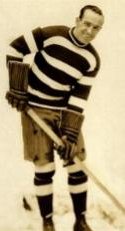 Ever wonder why a hockey jersey is often referred to as a sweater? Ever wonder why a hockey jersey is often referred to as a sweater?
Very simple -- in the old days of hockey, that's exactly what players wore -- sweaters. No different than the ones you'd find at your local men's store. Teams would often buy several sweaters of the same pattern, slap a number on the back and in some cases a logo on the front and call it a day.
To say the least, times have changed!
In this section, I will take you to the "Edge" and back.
Most early jerseys had patterns to them -- whether it be barber-pole stripes or chest bands of contrasting colors. With television still decades away from being invented, there was little need to outfit teams in more than one jersey. Certainly, everyone in the arena could tell a red jersey from a blue jersey -- right?
As the calendar moved into the late 1930s, solid color jerseys started taking shape. Crests would become more intricately designed, and pants would shift from a neutral canvas color to a color in the team's palette. Speaking of colors, most teams in the Original Six era used very traditional colors. From 1942 to 1967, jerseys were either red, blue, black, gold or white.
Then came expansion.

With the addition of six new teams, all of the sudden every color in the rainbow was represented on league jerseys. The Los Angeles Kings introduced purple (officially Forum blue) to the NHL landscape, the Philadelphia Flyers reintroduced orange, and the California (later Oakland) Seals and Minnesota North Stars took to the ice wearing green.
But if the NHL thought they had seen it all with the addition of those colors, they were sorely mistaken!
In 1970, flamboyant owner Charlie O. Finley bought the Oakland Seals and renamed them the California Golden Seals. He outfitted them in the same colors as he put his baseball team in -- kelly green and gold. He even had his players wear white skates! They looked like a bunch of figure skaters on the ice -- and given their win-loss records, they kind of played like them too. The Seals changed to teal after Finley sold the team in 1974.
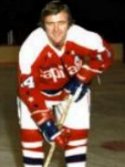 In 1975, the NHL expanded into Washington, DC, with the Washington Capitals. That team decided it might look good if the players wore white pants with their red jerseys. They couldn't have been more wrong if they predicted they would go to the playoffs in their inaugural year (they won only eight games). The white pants were the subject of massive ridicule and were quickly put to pasture. In 1975, the NHL expanded into Washington, DC, with the Washington Capitals. That team decided it might look good if the players wore white pants with their red jerseys. They couldn't have been more wrong if they predicted they would go to the playoffs in their inaugural year (they won only eight games). The white pants were the subject of massive ridicule and were quickly put to pasture.
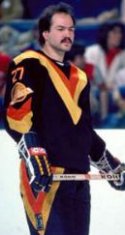 But perhaps the most radical design to come out of the late 1970s was that of the Vancouver Canucks. For a fee of $100,000, they hired San Francisco-based marketing firm Beyl, Boyd and Turner to redesign their conservative uniforms. What they got was one of the biggest eyesores in American professional sports history, with huge "V's" (which supposedly was supposed to stand for "victory" and not necessarily "Vancouver") all over. When Pat Quinn took over as general manager, one of the first things he did was have the uniforms redesigned. But perhaps the most radical design to come out of the late 1970s was that of the Vancouver Canucks. For a fee of $100,000, they hired San Francisco-based marketing firm Beyl, Boyd and Turner to redesign their conservative uniforms. What they got was one of the biggest eyesores in American professional sports history, with huge "V's" (which supposedly was supposed to stand for "victory" and not necessarily "Vancouver") all over. When Pat Quinn took over as general manager, one of the first things he did was have the uniforms redesigned.
 The 1970s also saw the re-introduction of names on the backs of the jerseys. The New York Americans experimented with them in 1926, and they got a thumbs-down. Another New York team, the Rangers, were one of the first teams to reintroduce them in the NHL, and this time they found acceptance. Until 1977, home teams could wear names at their discretion and road teams could wear them by permission of the home team. Starting with the 1977-78 season, names would be mandatory on all jerseys. In the beginning, names would be placed straight across. In 1982, the Red Wings became the first team to use vertically-arched names. The 1970s also saw the re-introduction of names on the backs of the jerseys. The New York Americans experimented with them in 1926, and they got a thumbs-down. Another New York team, the Rangers, were one of the first teams to reintroduce them in the NHL, and this time they found acceptance. Until 1977, home teams could wear names at their discretion and road teams could wear them by permission of the home team. Starting with the 1977-78 season, names would be mandatory on all jerseys. In the beginning, names would be placed straight across. In 1982, the Red Wings became the first team to use vertically-arched names.
After Bill Masterton of the Minnesota North Stars died of injuries suffered in a game in January 1968, helmet use starting becoming more widespread. In 1979, a new rule was put in place requiring all players signing their NHL contracts on ir after June 1, 1979, to wear helmets. That's why on this site, helmets start appearing with the uniform sets with the 1979-80 season.
 The NHL first tried to create a lighter uniform system in 1981 with the invention of Cooperalls -- which used long pants in place of the traditional short pants. The Flyers were the first team to go to the new style, followed by the Hartford Whalers. Players quickly found that the long pants made them slide faster on the ice whenever they took a spill, making it dangerous if they started careening towards the boards. The NHL banned Cooperalls following the 1982-83 season, and the Flyers and Whalers returned to the traditional short pants thereafter. The NHL first tried to create a lighter uniform system in 1981 with the invention of Cooperalls -- which used long pants in place of the traditional short pants. The Flyers were the first team to go to the new style, followed by the Hartford Whalers. Players quickly found that the long pants made them slide faster on the ice whenever they took a spill, making it dangerous if they started careening towards the boards. The NHL banned Cooperalls following the 1982-83 season, and the Flyers and Whalers returned to the traditional short pants thereafter.
In 1991, the NHL returned to the Bay Area with the birth of the San Jose Sharks, who reintroduced teal to the NHL's color palette. Their uniforms won very quick praise, and the NHL later used that color in the Eastern Conference's All-Star Game uniforms in the mid-90s. In 1993, the Mighty Ducks of Anaheim made their debut sporting official colors jade and eggplant.
 Some more wild designs started sprouting in the mid-1990s. The New York Islanders departed from their traditional uniforms and went with a wild design featuring a logo with a man bearing a striking resemblance to the Gorton's fisherman ("We want fishsticks" -Rangers fans taunting the Islanders). Those logos were retired after two seasons and the uniform design was gone after three. Some more wild designs started sprouting in the mid-1990s. The New York Islanders departed from their traditional uniforms and went with a wild design featuring a logo with a man bearing a striking resemblance to the Gorton's fisherman ("We want fishsticks" -Rangers fans taunting the Islanders). Those logos were retired after two seasons and the uniform design was gone after three.
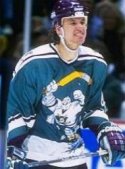 A few other teams raised some eyebrows in early 1996 as the NHL's third jersey program took off. The Mighty Ducks wore a jersey with a huge duck crashing through the ice wearing goalie equipment, and the Kings wore a white jersey with a logo on the upper left chest that bore a striking resemblance to Burger King's mascot. There would be several other wild designs in the third jersey program -- some of which became regular uniforms. A few other teams raised some eyebrows in early 1996 as the NHL's third jersey program took off. The Mighty Ducks wore a jersey with a huge duck crashing through the ice wearing goalie equipment, and the Kings wore a white jersey with a logo on the upper left chest that bore a striking resemblance to Burger King's mascot. There would be several other wild designs in the third jersey program -- some of which became regular uniforms.
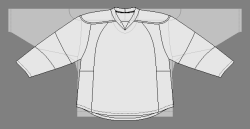 In the mid-2000s, the NHL commissioned its new exclusive uniform supplier, Reebok, to create a lighter, more breathable uniform. After two years of research and development, the NHL introduced the hockey world to the Reebok Edge uniform system at the 2007 All-Star Game. All 30 teams would go to the Edge uniforms the following season -- many keeping their old designs; some using the occasion to roll out new ones. A couple months into the 2007-08 season, after getting feedback from several players saying the new jerseys were trapping moisture rather than wicking it away, Reebok changed some of the materials and issued new jerseys to its teams. In the mid-2000s, the NHL commissioned its new exclusive uniform supplier, Reebok, to create a lighter, more breathable uniform. After two years of research and development, the NHL introduced the hockey world to the Reebok Edge uniform system at the 2007 All-Star Game. All 30 teams would go to the Edge uniforms the following season -- many keeping their old designs; some using the occasion to roll out new ones. A couple months into the 2007-08 season, after getting feedback from several players saying the new jerseys were trapping moisture rather than wicking it away, Reebok changed some of the materials and issued new jerseys to its teams.

The Edge uniform system lasted ten seasons until Adidas (which is the parent company of Reebok) took over the manufacturing of NHL jerseys and introduced the Adizero uniform system. Adidas kept the basic silhouette intact and introduced a few changes to the jersey construction, including a lighter shoulder yoke and a lay-flat collar. With the manufacturer changeover, all tail stripes now follow the contour of the curved hemline.
| 






 Ever wonder why a hockey jersey is often referred to as a sweater?
Ever wonder why a hockey jersey is often referred to as a sweater? In 1975, the NHL expanded into Washington, DC, with the Washington Capitals. That team decided it might look good if the players wore white pants with their red jerseys. They couldn't have been more wrong if they predicted they would go to the playoffs in their inaugural year (they won only eight games). The white pants were the subject of massive ridicule and were quickly put to pasture.
In 1975, the NHL expanded into Washington, DC, with the Washington Capitals. That team decided it might look good if the players wore white pants with their red jerseys. They couldn't have been more wrong if they predicted they would go to the playoffs in their inaugural year (they won only eight games). The white pants were the subject of massive ridicule and were quickly put to pasture. But perhaps the most radical design to come out of the late 1970s was that of the Vancouver Canucks. For a fee of $100,000, they hired San Francisco-based marketing firm Beyl, Boyd and Turner to redesign their conservative uniforms. What they got was one of the biggest eyesores in American professional sports history, with huge "V's" (which supposedly was supposed to stand for "victory" and not necessarily "Vancouver") all over. When Pat Quinn took over as general manager, one of the first things he did was have the uniforms redesigned.
But perhaps the most radical design to come out of the late 1970s was that of the Vancouver Canucks. For a fee of $100,000, they hired San Francisco-based marketing firm Beyl, Boyd and Turner to redesign their conservative uniforms. What they got was one of the biggest eyesores in American professional sports history, with huge "V's" (which supposedly was supposed to stand for "victory" and not necessarily "Vancouver") all over. When Pat Quinn took over as general manager, one of the first things he did was have the uniforms redesigned. The 1970s also saw the re-introduction of names on the backs of the jerseys. The New York Americans experimented with them in 1926, and they got a thumbs-down. Another New York team, the Rangers, were one of the first teams to reintroduce them in the NHL, and this time they found acceptance. Until 1977, home teams could wear names at their discretion and road teams could wear them by permission of the home team. Starting with the 1977-78 season, names would be mandatory on all jerseys. In the beginning, names would be placed straight across. In 1982, the Red Wings became the first team to use vertically-arched names.
The 1970s also saw the re-introduction of names on the backs of the jerseys. The New York Americans experimented with them in 1926, and they got a thumbs-down. Another New York team, the Rangers, were one of the first teams to reintroduce them in the NHL, and this time they found acceptance. Until 1977, home teams could wear names at their discretion and road teams could wear them by permission of the home team. Starting with the 1977-78 season, names would be mandatory on all jerseys. In the beginning, names would be placed straight across. In 1982, the Red Wings became the first team to use vertically-arched names. The NHL first tried to create a lighter uniform system in 1981 with the invention of Cooperalls -- which used long pants in place of the traditional short pants. The Flyers were the first team to go to the new style, followed by the Hartford Whalers. Players quickly found that the long pants made them slide faster on the ice whenever they took a spill, making it dangerous if they started careening towards the boards. The NHL banned Cooperalls following the 1982-83 season, and the Flyers and Whalers returned to the traditional short pants thereafter.
The NHL first tried to create a lighter uniform system in 1981 with the invention of Cooperalls -- which used long pants in place of the traditional short pants. The Flyers were the first team to go to the new style, followed by the Hartford Whalers. Players quickly found that the long pants made them slide faster on the ice whenever they took a spill, making it dangerous if they started careening towards the boards. The NHL banned Cooperalls following the 1982-83 season, and the Flyers and Whalers returned to the traditional short pants thereafter. Some more wild designs started sprouting in the mid-1990s. The New York Islanders departed from their traditional uniforms and went with a wild design featuring a logo with a man bearing a striking resemblance to the Gorton's fisherman ("We want fishsticks" -Rangers fans taunting the Islanders). Those logos were retired after two seasons and the uniform design was gone after three.
Some more wild designs started sprouting in the mid-1990s. The New York Islanders departed from their traditional uniforms and went with a wild design featuring a logo with a man bearing a striking resemblance to the Gorton's fisherman ("We want fishsticks" -Rangers fans taunting the Islanders). Those logos were retired after two seasons and the uniform design was gone after three. A few other teams raised some eyebrows in early 1996 as the NHL's third jersey program took off. The Mighty Ducks wore a jersey with a huge duck crashing through the ice wearing goalie equipment, and the Kings wore a white jersey with a logo on the upper left chest that bore a striking resemblance to Burger King's mascot. There would be several other wild designs in the third jersey program -- some of which became regular uniforms.
A few other teams raised some eyebrows in early 1996 as the NHL's third jersey program took off. The Mighty Ducks wore a jersey with a huge duck crashing through the ice wearing goalie equipment, and the Kings wore a white jersey with a logo on the upper left chest that bore a striking resemblance to Burger King's mascot. There would be several other wild designs in the third jersey program -- some of which became regular uniforms. In the mid-2000s, the NHL commissioned its new exclusive uniform supplier, Reebok, to create a lighter, more breathable uniform. After two years of research and development, the NHL introduced the hockey world to the Reebok Edge uniform system at the 2007 All-Star Game. All 30 teams would go to the Edge uniforms the following season -- many keeping their old designs; some using the occasion to roll out new ones. A couple months into the 2007-08 season, after getting feedback from several players saying the new jerseys were trapping moisture rather than wicking it away, Reebok changed some of the materials and issued new jerseys to its teams.
In the mid-2000s, the NHL commissioned its new exclusive uniform supplier, Reebok, to create a lighter, more breathable uniform. After two years of research and development, the NHL introduced the hockey world to the Reebok Edge uniform system at the 2007 All-Star Game. All 30 teams would go to the Edge uniforms the following season -- many keeping their old designs; some using the occasion to roll out new ones. A couple months into the 2007-08 season, after getting feedback from several players saying the new jerseys were trapping moisture rather than wicking it away, Reebok changed some of the materials and issued new jerseys to its teams.